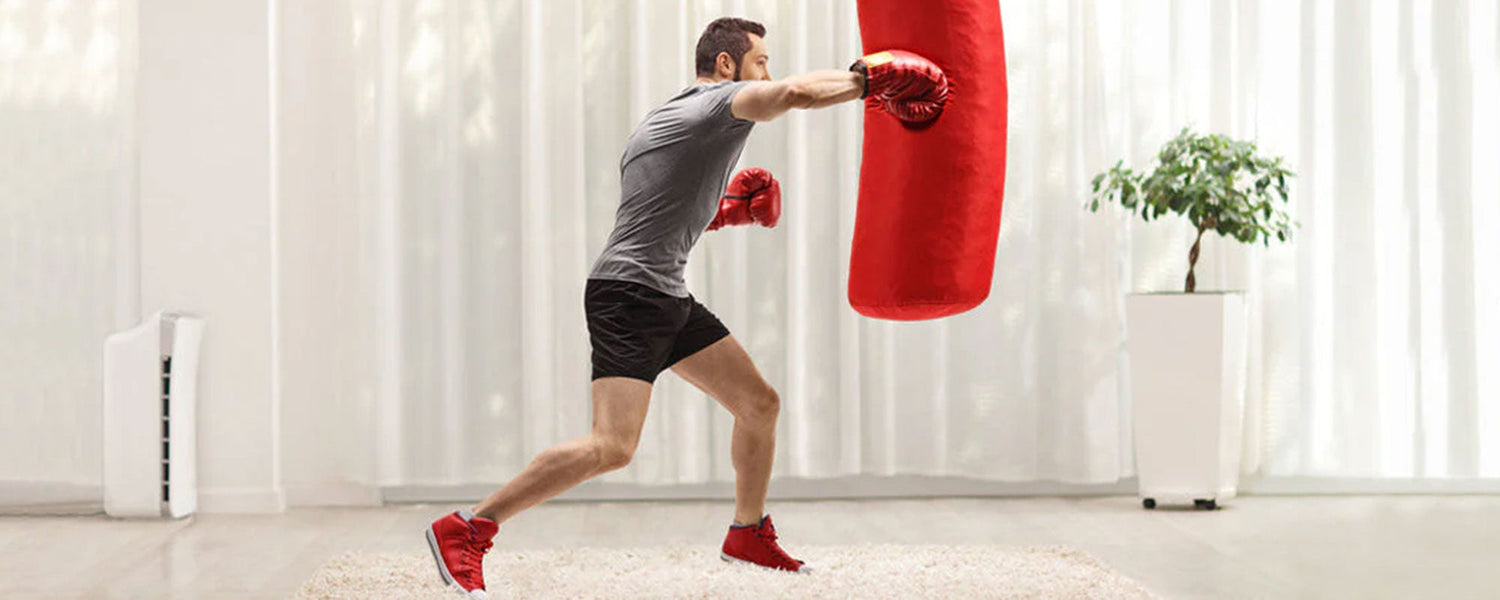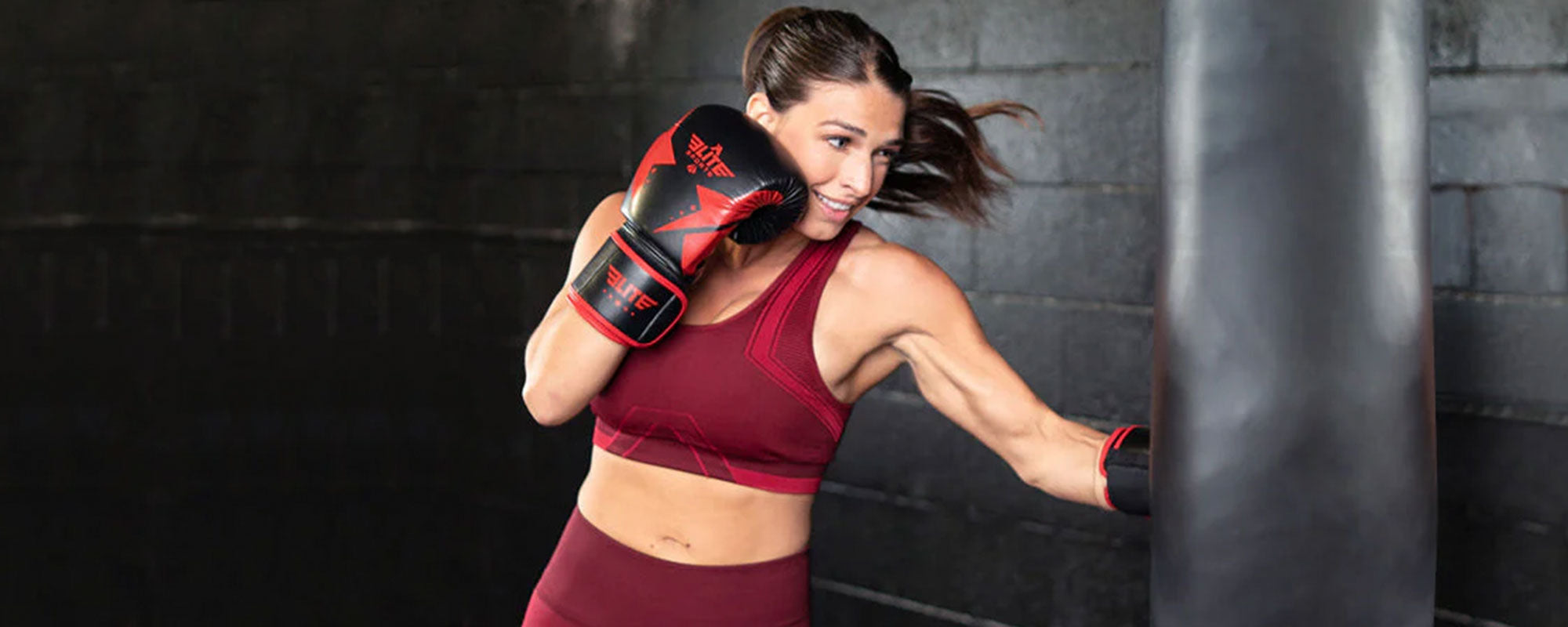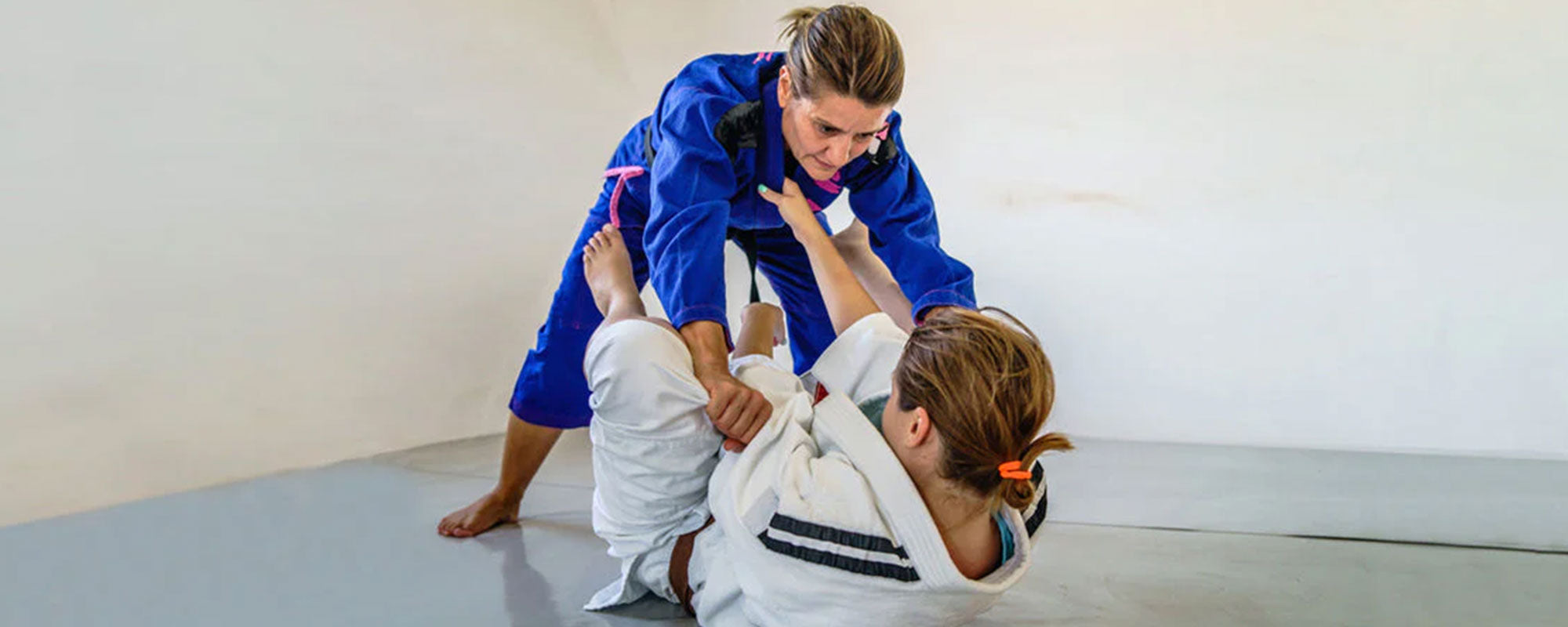Table of content
It is an undeniable fact that boxing is one of the most demanding sports around the globe. To reach the top, boxers need to have a defined set of skills like endurance, agility, speed, and power.
Elite athletes attain these skills by training hard at gyms and by spending hours on training and while following strict diet plans. Needless to say, it is hard for everyone to become the next Ali or Mayweather. However, individuals like you can still enjoy a lot of benefits by training in the same fashion at home if you cannot afford gym fees and other associated expenses.
Below, you’ll find a comprehensive boxing training guide for beginners to train like a boxer at home that can help you improve your skills, techniques, and to get in boxing shape.
1. The Most Effective Boxing Workout Routine
For proper workouts, you are required to have effective techniques and conditioning. You should be able to land punches with the most precision while having the endurance to last many rounds during your training. In other words, you are required to build physical strength and mental toughness to be able to withstand actual fights.
As a boxing beginner, you can utilize a number of workout routines and plans for optimizing your performance. Here is the most effective boxing training program that most boxers use.
- 2-3 times a week strength training.
- 2-3 days a week punching bag workout.
- 2-3 days a week speed bag training.
You can go for this workout routine for the maximum benefits. For improving your stamina and endurance, it will be vital to run on a daily basis. This cardio-based personal boxing training routine will not just help you improve your boxing skills but also benefit in losing body fat.
2. Eat Like a Boxer
A boxer’s performance not just depends on the training hours but also on diet. Boxers are required to follow the dietary guidelines quite strictly to remain in shape and reach peak performance.
2.1. Foods to Eat
Here are some of the most suggested foods for boxers:
2.1.1. Carbohydrates
Boxing workouts and training sessions take plenty of energy and to replenish that energy it is essential to take carbohydrates. They will restore the depleted glycogen stores while exercising.
Complex carbs are found quite effective as they afford maximum nutrients to the body and provide vitamins that any random carbohydrates lack in. When you provide your body with the right amount of carbohydrates, it helps you keep blood sugar levels stable so you can make the most out of your workouts.
Whole grains, fruits, and vegetables are some examples of complex carbs with the maximum nutrients.
2.1.2. Proteins
Building muscles and getting into a fighting shape using protein-based food items always helps. That is why most pro boxers use their muscles to the maximum during training and workouts to break them with the goal of rebuilding them once the workout ends. This exhibits that protein has an important role to play in pre and after-workout meals.
Beans, red meats, chicken, and cheese are some examples of protein-based food items that you incline in your diet plan.
Also read: Eat Like a Boxer: A Healthy Boxer's Diet
2.1.3. Healthy Fats
Fats are also an essential part of the essential macronutrients that a body needs besides carbohydrates and proteins. A balanced and healthy diet always includes healthful polyunsaturated and monounsaturated fats.
While designing your diet plan, you must be including fat-oriented food items like avocados, nuts, olive oil, fish, and seeds.
2.2. Foods to Avoid
There are certain food items that do not help boxers while working out but can damage their digestive system. Junk foods like pizzas, burgers, and other oily products always cause damage to the digestive system. They do not have any real nutrients.
Similarly, high-fat foods should also be avoided as there is no reason to intake extra fat before you burn it in your training.
3. Basic Boxing Skills Beginners Should Learn
To achieve mastery in boxing, it is essential to master the movements and techniques that it involves. Here are some of the most important and commonly taught boxing skills that you should learn for accomplishing your goals.
3.1. Perfect Stance
If you do not know what is the perfect stance in boxing and how to get in position while sparring, you cannot achieve in this sport. For both attack and defense point of view, the stance is of great importance.
You must be learning the right boxing stance to excel in the sport. In this respect, there are multiple instructional available on different online resources that you can use to learn the right posture to train at home.
To be in the right stance, keep your feet a shoulder-length apart, put your majority of the weight on the balls of your lead foot, keep the heel of your rear foot slightly off the ground, bend knees, keep both hands at chin level in front of your face.
3.2. Footwork
Footwork is another key skill that plays an important role in differentiating boxing pros and averages. As a beginner, you must be giving importance to improving your footwork to be unstoppable and unpredictable for your opponents.
While learning footwork, you must be following the famous quote of Legend Muhammad Ali:
“Float like a butterfly, sting like a bee. Your hands can’t hit what your eyes can’t see”.
The better your footwork will be, the better you can dodge and attack your opponents in the actual fights.
3.3. Punching
With amazing footwork and stance, knowing how to punch opponents in a more accurate way is also necessary for beginners. Just flailing arms in the air is not what we call punching in boxing. A perfect punch involves multiple elements. Along with the posture, you must be aware of using the right part of your body and muscles for throwing an impactful punch at your opponent.
The perfect punch requires you to involve your entire body as power comes from your legs and torso. Bend your knees, twist your torso towards the target, and transfer the energy to your shoulders and then fists to throw a perfect punch.
There are multiple instructional tutorials available on the internet that can help you learn this skill at home.
3.4. Speed
Power is not the only factor that makes a punch powerful, speed also has an important role. Irrespective of the weight of your hand and the power you add to your punches, if you lack in speed, your punches are easy to predict and block. Though alone speed does not make sufficient impact, it helps you to hit the target most of the time. And, if you combine both speed and weight behind your punch, you can make the maximum out of your punches.
Therefore, all of these basic skills are essential to learn to be an unstoppable boxer in the future.
Also read: The Ultimate Beginner’s Guide to Boxing
4. Basic Boxing Techniques Beginners Should Learn
Unlike other combatting sports, boxing is with limited techniques and moves to master. There are just 4 major types of punching techniques and 2 movements that are essential to learning for a beginner.
4.1. Jab
The very first punch that you learn in a boxing class is the jab. You start this by getting into a boxer’s stance and bringing your hands in front of your face. While throwing your punch, your back heels should be slightly off to the ground, closed fists and fingertips facing your chin.
Punch straight out with your lead hand by twisting knuckles while extending the arm. You must be keeping your rear hand tight and ready in front of your face at the same time. After throwing the punch be quick to be in your starting position.
4.2. Cross
Cross is the second most important straight powerful punch that beginners should learn in their boxing training at home. This punch is known as a knockout punch that boxers use in different situations during fights.
This is a jab but is thrown with the rear hand. Start with a boxer’s stance and transfer most of your weight on your front foot, bend your knees slightly, punch your right hand forward with fingertips facing the floor at the time your arm is extended fully. While throwing a cross, rotate your hips and pivot on the balls of your back foot. As soon as you throw a punch, your hand should return to the initial position immediately.
4.3. Hook
The hook is a type of punch that is thrown with both hands and is known as lead hook and rear hook. This is one of the most effective punches that every boxer loves to have in the arsenal. Here is how you can throw it properly with each hand.
You should start with a normal boxing stance with hands in front of your face. Now rotate your body to transfer weight on the lead foot. Then bring your arm at shoulder height while bending your elbow at a 90-degree angle. Pivot your lead leg while swinging your arm at the target. Complete this punch by bringing your elbow back to the initial position. You can throw this punch with both hands with very little difference in technique and weight transfer.
4.4. Uppercut
Uppercut is the most effective short-range punch and like hooks, this can also be thrown with both hands. Both rear and lead uppercuts are similar in technique but are different when it comes to using hands.
Whichever hand you are using, you should start with the basic fighting stance with bent knees into a lower squat, drop your arm to 90° from your body, and using your power generated by legs and torso push your fist upward while keeping your elbow bent.
4.5. Slip
Besides learning punching techniques, learning defense is also a must for beginners. Slip is one of the best tactics that you can use to dodge an opponent's punches and stay in balance to place counters. Slip is a head movement that helps boxers in getting out of the path of coming punches from opponents.
To perform slips effectively, it is vital to have your sight focused on the opponent's movements. Losing focus always results in getting a hit with an unpredicted punch. To slip an opponent's punch, you just have to move your head to the opposite side by rotating your torso.
For example, when the opponent strikes from the right side, you should rotate your torso to the left, drop your left shoulder, bend your knees, and crunch to the left side to get out of the range of their punchline. The same can be done if the opponent strikes from the other side.
4.6. Roll
Like slipping, a roll is another effective tactic to avoid the opponent’s hooks. This is also essential to learn for boxing beginners to keep themselves safe from opponents.
You can roll by bending your knees and transferring your weight from the lead side to the backside. You can do this on the opposite side as well. To make the most out of this defensive technique, you should also learn to predict the opponent’s moves and punches so you can react timely to dodge and counter.
5. Boxing Gears Required to Train at Home
Training at home cannot be similar to training in a boxing gym. Boxing gyms have all kinds of equipment required for training and workouts. However, by having some essential training gear, one can also train at home. Here are some of the most essential boxing gear that you will need for boxing training at home like a professional boxer.
5.1. Hand Wraps

Hand wraps are essential to keep your hands protected while practicing your punches on bags. They are required to keep your bones and joints together. There are two types of hand wraps, the first one are traditional hand wraps and the other are quick hand wraps. Quick hand wraps are effective for those who do not know how to wrap hands.
5.2. Training Bags

For training at home, you are also required to have all punching bags including heavy bag, speed, bag, and double end bag. They are essential for making your punching technique perfect by practicing them when you do not have any sparring partner. They are also required for multiple workouts designed to improve endurance, speed, and strength.
5.3. Skipping Rope

Skipping rope is a kind of tool that boxers and other fighting athletes use for warming up before starting their training sessions. Having this in your training gear collection can help you get a perfect warm up as skipping rope always helps in warming blood to perform your workouts and training without facing any issues. There are a number of types of skipping ropes available in the market from where you can choose that you find suitable.
Also read: Learn Boxing at Home During Quarantine
5.4. Light Hand Weights

Light hand weights are another must-have equipment for boxing training at home specifically for shadow boxing. Shadow boxing with weights has a lot of benefits for boxers. They always help in improving power punching.
5.5. Boxing Gloves

While intending for boxing training, you cannot ignore boxing gloves. They provide cushioning to hands and absolve the effect when you throw punches on heavy bags or at your training partner. Punching bags with bare knuckles can cause joint dislocations and tearing muscles. Therefore, it is essential to have a pair of high-quality boxing for the best boxing training outcomes.
5.6. Resistance Bands

Adding resistance bands to your training gears can be beneficial for you in multiple ways. For example, when you are not in the mood for shadow boxing or sparring, you can use them for muscle building. You can use them in any way you want, unlike weights.
5.7. Boxing Rash Guards

To train without facing troubles like irritation due to sweat or abstraction in movements, having rash guards is essential whether you're training in a gym or at home. They also prevent you from getting rashes or mat burns during training sessions. They also minimize the chances of upper-body injuries by keeping every part of your body altogether.
5.8. A Partner and Mitts

If you are living with a person who also loves boxing, you are very lucky indeed. In such a case, having a good pair of boxing mitts will be quite beneficial to train together. Having a partner is also beneficial when it comes to correcting techniques and practicing different punching combinations.
6. A Comprehensive Boxing Workout At Home
Here is a comprehensive boxing workout plan for training boxing at home to get in a fighting shape as well as improving your boxing skills.
6.1. Warm Up
You must be starting your boxing workouts designed for home with traditional warm-up exercises. The following are some dynamic exercises that can help you warm up your muscles to get them ready for the actual workout.
- Calf raises 10 times.
- Walking toe taps 10 times (opposite hand to foot).
- 10 reps of Hamstring scoops.
- 10 reps of lateral lunge.
- 10 yards high knees forward and backward.
6.2. Round 1
To train like a professional boxer at home, you should be starting with the basic techniques. Start with the first round with the mix of jab, cross, and hook punches as;
- Perform jab for one minute.
- Perform jab/cross for one minute.
- Perform jab/cross/hook for one minute.
6.3. Round 2
In round two mix up some traditional exercises with your freestyle training.
- Perform 10 punches (any punch) for one minute. Perform one push up after 10 punches.
- Perform 10 punches for one minute followed by a squat.
- Perform 10 punches for one minute followed by a lunge.
6.4. Round 3
Now it is the time to level up the intensity of your workout. In this round work on your body movements in the following way.
- Perform slip/slip for one minute.
- Perform roll/roll for one minute.
- Perform slip/slip/roll/roll for one minute.
6.5. Round 4
To get great cardio in this round, you should combine the elements included in rounds 2 and 3.
- Perform jab/cross/slip/slip.
- Perform cross/hook/roll/roll.
- Perform jab/cross/hook. slip/slip/roll/roll.
You can perform these exercises for the amount of time that makes you feel exhausted and increase your heart rate.
6.6. Round 5
To increase the intensity level of your training, perform 20 punches followed by a squat ten times by increasing the number of squats by one after every 20 punches.
7. Takeaway
Adding the above-described workout program to train like a boxer at home can really help you not just in improving your boxing skills but also physical fitness. Being a beginner, considering all the explained guidelines can help you accomplish your goals rapidly without any gym expenditures. However, joining a boxing gym holds plenty of additional benefits such as the support of an instructor who can help you correct your technique. In addition, you also get sparring partners at gyms who make it easy for you to practice your techniques as you do in an actual fight.
Photo Credit: maxxproboxing



Leave a comment
This site is protected by hCaptcha and the hCaptcha Privacy Policy and Terms of Service apply.